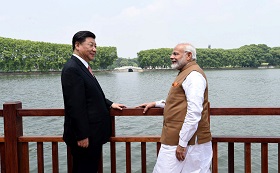The territorial aspect of politics is determined not only by objective factors but also by subjective notions about territory constructed by people. International relations model interpreting modern international relations as the conflict between geographic West and East is a vivid example of such a phenomenon. Let us discover the origins of such an approach and its variations.
People’s consciousness has dialectical character hence world political space is structured through separation. At the highest level, such separation is represented by binary geopolitical systems under which the world is defined through the competition between the two antagonistic parts. This model has had many variations. “Civilization vs. Barbarhood” seems to be the most ancient embodiment of the model. The “Civilization vs Barbarhood” type of model, within which there exists disengagement between those who accept some common achievements, values, rules and those who do not, nowadays is considered to be politically incorrect, however it is still applied in public discourse.
The second variation is represented by the dichotomy between the Old World and the New World — so as the opposition between the regions known by Europeans before the Age of Discovery (Europe, Asia, Africa) and the regions opened by them during the Age of Discovery (America and Australia).
In fact the two above mentioned models replicate at their core the most resilient geopolitical binary system, “West vs. East”. The mental commonality of global West (Europe, America, Australia) was constructed via its contrasting to the global East (Asia and Africa), first of all, to Arabs, Turks, and Russians. For this purpose, the West artificially attributed to the East antagonistic traits, such as tyranny, mysticism, collectivism. This process called orientalism was challenged by the opposite one known as occidentalism characterized by the East’s describing the West in terms opposite to its self-description (exceptionalism, expansionism, and mercantilism).
Critical geopolitics claims that the West/non-West
opposition is nothing more than a socially constructed model which should be
used with extreme caution due to its contradictory nature. The non-West will
never become the West in any sense of this word as long as it agrees with such
division, recognizes the existence of a certain West and its attempts to evolve
into it.
The territorial aspect of politics is determined not only by objective factors but also by subjective notions about territory constructed by people. International relations model interpreting modern international relations as the conflict between geographic West and East is a vivid example of such a phenomenon. Let us discover the origins of such an approach and its variations.
The Crimean crisis has revived the discourse standing that there are civilizational differences between Russia and the West, which can be expressed by the thesis “Russia is not the West” and vice versa. Thus, this international political conflict started to be interpreted as a clash between territorial images of the West and Russia/Eurasia/East, consequently becoming constructively geopolitical. The discourse mentioned above seems to stem back to the middle of the XV century, when Christian post roman identity (which used to encompass the Kievan Rus) was supplemented by a territorial characteristic, hence creating the boundaries of modern European civilization. In this time to understand themselves, Europeans adopted the Greek picture of the world that is defined via opposition between the European Aegean civilization and Asian Persia. This phenomenon at the end of the Middle Ages is related to almost simultaneous success of the Reconquista in the Pyrenean and the fall of Constantinople in the Balkans, which led to the situation when the boundaries of Christian World began to overlap more with the continental boundaries. Such territorial image demanded the formation of European civilization mental boundaries in the East. The Horde’s yoke in Rus and the Moscow kingdom’s attempts to create a national idea based on the premise that Moscow is the descendant of Byzantium were the reasons for drawing eastern mental boundaries of European civilization in a way that excludes Orthodox Russia with construction of a buffer zone between Western Europe and Russia including Slavic, Baltic and Finno-Ugric nations. This discourse imported in Russian in the XVIII century embodied a key dichotomy of Russian foreign policy orientation, which is expressed in constant disputes between Slavophil’s and Westerners. Lately, the discourse has gone under rethinking and reduction from “Russia is not the West” to “Russia is anti-West,” which has led to the conflict escalation along the border of Europe and Russia, first of all, in Ukraine, Georgia, and Moldova. The civil war in Ukraine caused the construction of a myth according to which the Ancient Rus gave birth to two states, — European democratic Ukrainian state and the oriental despotic Russian state. The antagonism between the two entities has led to the reinterpretation of European identity among Ukrainians as anti-Russian. This dispute generated similar discourses of Moldova’s, Belorussia’s, Georgia’s, Armenia’s being European nations in contrast with Asian Russia. In fact, we observe the reactualisation of the most ancient and sustained geopolitical concepts presenting the world as a confrontation between two antagonistic concepts of white and black.
Antagonistic geopolitical system West/Non-West
People’s consciousness has dialectical character hence world political space is structured through separation. At the highest level, such separation is represented by binary geopolitical systems under which the world is defined through the competition between the two antagonistic parts. This model has had many variations. “Civilization vs. Barbarhood” seems to be the most ancient embodiment of the model. The “Civilization vs Barbarhood” type of model, within which there exists disengagement between those who accept some common achievements, values, rules and those who do not, nowadays is considered to be politically incorrect, however it is still applied in public discourse.
The second variation is represented by the dichotomy between the Old World and the New World — so as the opposition between the regions known by Europeans before the Age of Discovery (Europe, Asia, Africa) and the regions opened by them during the Age of Discovery (America and Australia).
In fact the two above mentioned models replicate at their core the most resilient geopolitical binary system, “West vs. East”. The mental commonality of global West (Europe, America, Australia) was constructed via its contrasting to the global East (Asia and Africa), first of all, to Arabs, Turks, and Russians. For this purpose, the West artificially attributed to the East antagonistic traits, such as tyranny, mysticism, collectivism. This process called orientalism was challenged by the opposite one known as occidentalism characterized by the East’s describing the West in terms opposite to its self-description (exceptionalism, expansionism and mercantilism).
During Bipolarism the West vs. East system was reduced to the Western vs. Eastern block model. In the course of the Cold War the East/West system was also used to describe the ideological divide between capitalist and socialist countries. The western block was comprised of the USA and other NATO-members while the eastern one led by the USSR consisted mainly from the nations members to the Warsaw Pact and the Comecon.
Today West/East model is layered by another model with the similar internal logic — North vs. South model. It reflects the separation of the world between the developed countries (Europe, North America, Australia) and developing (Asia, Africa, South America). In the more archaic interpretation, it represents the division between the exploiting and exploited nations. The model portrays disproportions of global development: the Global North accounts for 1/3 world population and 4/5 of income whereas the Global South makes up 2/3 of population and 1/5 of income. The border between the North and South, which passes approximately along the 30th parallel of north latitude, is called Brandt’s line in the name of German Chancellor who suggested such a description of the border.
Table 1 shows the continent’s conformity to the existing binary geopolitical systems. Binary geopolitical systems may exist at the national level as well, for example Western Germany vs. Eastern Germany, North vs. South in the USA or Italy. Binary geopolitical systems are close to a physical-geographic term hemispheres of the Earth. There are northern and southern (the equator is the border), western and eastern (a more conditional border, which is marked by the Greenwich meridian), mainland and oceanic hemispheres. The fact that precisely the Greenwich meridian was chosen as the Prime meridian among other candidates such as the Paris meridian and the Pulkovo one in Saint Petersburg demonstrates how important subjective human perception is when it comes to establishing global dichotomies. Arbitrary character of the notions West and East and their detachment from geography are also proved by the fact that geographically eastern- and south-located Australia from political perspective is a part of the West and North.
Table 1. Binary geopolitical systems
|
Part of World
|
Old vs. New World
|
West vs. East
|
North vs. South
|
|
Europe
|
Old World
|
West
|
North
|
|
Asia
|
Old World
|
East
|
South
|
|
Africa
|
Old World
|
East
|
South
|
|
North America
|
New World
|
West
|
North
|
|
South America
|
New World
|
West
|
South
|
|
Australia and Oceania
|
New World
|
West
|
North
|
In the academic science along with binary geopolitical systems, trinary systems are often defined. They consist of three basic elements and present the result of binary systems’ natural development. Trinary systems are also based on the world dialectic principle, according to which the world is divided into two antagonistic parts; however, they add an interim layer to these two poles, which separates and balances the extreme models. The most widely known trinary geopolitical system models are the following.
First of all, it is the “First vs. Second vs. Third World” model that is a developed type of Cold War binary system, which used to divide the world into the First World capitalist states and Second World socialist ones. In the 1950s as a counterbalance to the two ideological blocks, the Non-Aligned Movement emerged. This Movement was aimed at nations’ development without joining either of the existing politico-military blocks (mainly the NATO and Warsaw Pact) and widely speaking without strict orientation on any from conflicting ideologies. Yugoslavia, Egypt, and India became the leaders of the Movement. Because the majority of Movement member states were post-colonial developing countries, the term “Third World” started to denote countries falling behind economically.
Another more academic scheme “Center vs. Semi-periphery stems from the world-systems perspective (I. Wallerstein, A. Frank) that sees the world as an integrated politically-economic system within which there exist the exploiting and highly developed core, the underdeveloped and exploited by the center-periphery and semi-periphery, whose objective is to soften the antagonistic interests of the center and the periphery and shift potential pressure on the center coming from the periphery. The semi-periphery in this system seeks to join the core and avoid becoming the periphery. The existence of periphery and semi-periphery, which constrains it, is an essential condition and direct effect of core’s domination and it is in the core’s interest that this artificial “ladder” of development remains.
Mao Zedong’s “Three worlds” system is another vivid example of trinary scheme. According to this system there exist the First world of superpowers (the USA, the USSR), the Second world of “interim countries” (Europe, Canada, Japan, Australia) and the Third world that comprises the rest. As you can see this model rests on the binary opposition between the exploiting North and developing exploited South. Nevertheless, the third group of countries is formed not from the countries of the South but from the northern countries, which are separated into political leaders and their developed satellites. The widely used term “Third World countries” applied to denote states falling short in terms of economic development is closer to Zedong’s Three worlds perspective rather than the western one.
The West/non-West System as the Resurgence of the Land/Sea Dichotomy
There exists another dichotomy that has taken roots in western geopolitics, namely Land vs Sea. In fact, it represents a continuation of the same opposition between colonial Empires of the West and continental powers of the East. This distinction implies the world division into maritime-based powers (Thalassocracy which domination is ensured by the Navy and merchant fleets) and land-based powers (Tellurocracy that relies upon the army and control over land-locked resources). Although there exist pure types like 1) pure Thalassocracy (British Empire) and 2) pure Tellurocracy (Mongolian Empire), most countries fall into the category of mixed types such as 3) Thalassocracy-leaning (the USA), 4) Tellurocracy-leaning (Russia) and 5) fluctuating between Thalassocracy and Tellurocracy (France during the Napoleonic Wars as a colonial empire).
Such scholars of the Anglo-American school of geopolitics as А. Mahan, John Mackinder, and N. Spykman have provided a valid physical-geographical explanation of world political processes by means of the analysis of the characteristics typical of the maritime or continental position of the leading powers. And it’s exactly what later evolved into concepts of the Heartland, Lenaland, and Rimland.
Since the Earth's surface is a combination of unevenly and inconsistently located land and sea spaces, extensive growth of any nation was determined by its geographical location. Located on an island or in the coastal area this nation drew upon its naval forces evolving therefore into a Sea power while Continental powers were formed in the continent inland areas where nations had to rely on its land forces giving rise to Continental powers. This leads us to conclude that the structure of the world spatiality made it impossible for world hegemon to appear as the strongest Navy is almost powerless against the best land army and Vice versa.
Since the use of only one type of force has numerous constraints, Sea and Continental powers seek to possess the other type of force. Indeed, Continental powers try to obtain a lasting access to the world's oceans while Sea powers endeavor to lay hands on the resources within the continent using rivers and road, stretching from the coastal ports deep into the continent. However, there exists a region inaccessible to a Sea power called the Heartland. This region situated in the middle of Eurasia is protected by deserts and large mountain systems and what is more important the rivers running there like the Volga, Ural, Angara, Syr Darya, Amu Darya don’t flow into any ocean. Thus, together with the Lenaland, in the North-Eastern part of Eurasia, there is a vast expanse which is completely out of reach of any Sea power. And whoever controls this region will turn into the most powerful State in the world.
Building on this theory, H. Mackinder considered the Heartland along with the Lenaland “the geographical pivot of history,” that is an area which enabled a State possessing it to determine international politics. The British scholar claimed therefore that in the 20th century Central Asia and Afghanistan in particular would be a region many States would struggle to possess. However, the First and Second World Wars fought over Eastern Europe made Mackinder reexamine his views. Committed to his theory, he argued that the best way to reach the Heartland was now through the Intermarium region located between two East European seas which have a dual structure. This means if the Danish and Turkish Straits are blocked then they become lakes, thereby cutting off the power of the Heartland from the World Ocean. Mackinder also developed the strategy of Atlanticism which was based on the premise that the coastal States of the North Atlantic should cooperate as it was as crucial part of the Ocean as the Heartland is of the Land. It is worth noting that this strategy laid the groundwork for the creation of NATO.
Famous American geopolitician Nicholas Spykman developed the theory of H. Mackinder introducing the concept of the Rimland, land areas encircling the Heartland. Unlike Mackinder, Spykman sought to understand how to prevent the domination of the country that possessed the Heartland rather than how to reach and control it. Thus, he can be considered as the founder of the revisionist geopolitics that focused on securing rather than expanding. Indeed, to deal with the Soviet Union Spykman suggested that the Heartland should be surrounded by countries disloyal to the USSR that are torn apart by internal conflicts such as North Korea, China, Afghanistan, Iran, the Middle East, Turkey, Hungary, the Czech Republic, and Germany.
Although often criticized for being obsolete in the era of globalized economy, transcontinental aviation, and nuclear weapons, concentric geopolitical models had a significant impact on the development of Russian geopolitics, primarily on Eurasianism which sought to strengthen the position of Russia in the Heartland. Another interpretation of the Hartland theory was the model of the Intermediate Region designed by D. Kitsikis who argued that the pivotal part of the planet had shifted from Central Asia to the Middle East where Europe, Asia, and Africa come together.
Orientalism and Occidentalism
As can be seen, the re-emerging West/non-West opposition represents nothing more than a revival of old analytical models reaffirming the dominance of the West over non-Western countries. E. Said in his book called "Orientalism" argues that the identity of the post-colonial Orient didn't develop in an autochthonous manner but was imposed by the West. The author goes on to state that in the Middle ages the West was trying to form its shared civilizational identity by contrasting itself with the Muslim East. So, given marginal interaction between these two civilizations, the Western countries attached to the Orient characteristics opposite to European ones. Thus, with the colonization of the East, Europe imposed on it those stereotypes, which the Orient eventually embraced and started to develop. As a result, in the post-colonial era, the East continues to reproduce stereotypical ideas about itself imposed be the West in order to form its own civilizational identity. This leads us to the conclusion that the adoption of such stereotypes by the East came along with its subordinate position towards Western culture.
National liberation movements studied by F. Fanon, A. Memmi and other scholars represent another example of the post-colonial heritage. In their struggle against dependency on the West African and Asian countries used the narrative of national liberation movements in Europe. As African and Asian countries followed the pattern of European nation-States in their process of state-building, it still hinders the stabilization of many political systems in Africa and the Middle East. Moreover, in the process of state-building, the decolonization leaders having Western education and expertise in colonial administrations used approaches tailored for the metropoles.
In the1960's and 1970s G. Spivak developed a new trend in post-colonial studies called subalternism which can be seen as one of the forms of post-colonial dependency characterized by the analysis of literature, narratives and symbolic systems borrowed from the metropoles.
By the end of the twentieth century, the geopolitics was disappointed with the classical concepts involving the confrontation of Sea and Land powers, of the West and the East, the North and the South, the struggle for Hartland and Rimland etc., as each of which had at least two significant analytical constraints. First of all, those concepts explained only the relevant at that time international situation (for example, Rimland could help to understand the balance of power during the Cold War, but failed to explain the post-bipolar geopolitical balance). Secondly, they were susceptible to ideological impact and depended heavily on the positions of the concept’s founder.
In the 1990s appeared so-called critical geopolitics illustrating the shift towards a post-positivist approach in studying geopolitics. Critical geopolitics says that geopolitical strategy of the State has nothing to do with fundamental laws of nature and spatial structures, it draws rather upon geographical imagination and spatial myths, in other words, upon the image of the ideal world. The history of critical geopolitics dates back to 1992 when Gerald O’Tuathail and John Agnew published their article "Geopolitics and discourse: Practical geopolitical reasoning in American foreign policy" where they state that it is geography that determines all geopolitical models, which classical geopolitics did not take into account at all. However, critical geopolitics may have originated in the French school of geopolitics, in particular, in the works of Yves Lacoste and Michel Foucher or even in the iconography of Jean Gottmann and geographic possibilism of Paul Vidal de La Blache.
Critical geopolitics claims that the West/non-West opposition is nothing more than a socially constructed model which should be used with extreme caution due to its contradictory nature. The non-West will never become the West in any sense of this word as long as it agrees with such division, recognizes the existence of a certain West and its attempts to evolve into it.










